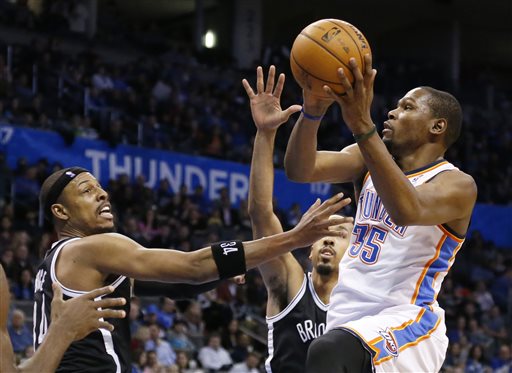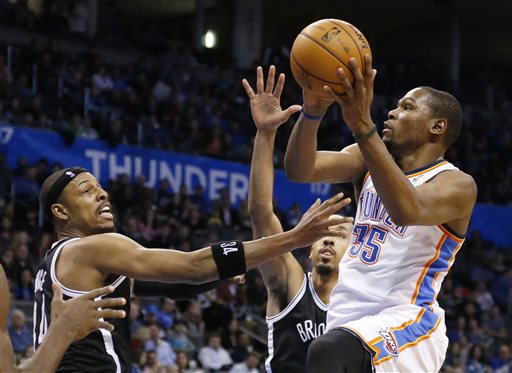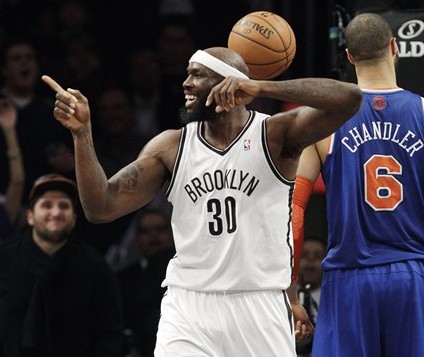
The Brooklyn Nets are riding high, on a three-game win streak since the break of the new year. Coach Jason Kidd’s superstition of not wearing ties has paid off, and the team was even able to pull off a victory over a solid Atlanta Hawks team despite missing point guard Deron Williams and center Brook Lopez.
In the three games since the new year, the Nets do look like a new team. They’ve allowed just 97.2 points per 100 possessions in 2014, and their +6.3 net rating would rank fifth-best in the NBA over the course of an entire year.
But small sample sizes can be wonky; guys can play to inflated levels in short bursts even without a change in process. Though the Nets have looked solid, particularly at limiting points in the paint and transition opportunities, there are still some significant issues that need resolution.
For one, the Nets still seem confounded by even a simple high pick-and-roll, and their lack of communication leaves their defense scrambling to recover. The Nets allow pick-and-roll ballhandlers to score 0.87 points per possession, the worst figure in the league, according to Synergy Sports.
Here’s one example of that miscommunication from last night’s game. With the Nets up 86-81 and just over 90 seconds left, the Hawks race into their frontcourt to create an opportunity. It’s a simple one: a high pick-and-roll with Jeff Teague and Pero Antic.
At first, the Nets play this according to plan: Teague begins with the ball on the defense’s left side, and the Nets defense has positioned itself in the “strong side” area. You’ll see that Shaun Livingston, guarding DeMarre Carroll in the weak side corner, has stepped into the paint to briefly deter Teague’s potential driving lane before sliding over to Carroll.
Teletovic “shows” on the high screen, limiting Teague’s ability to dribble-penetrate and, briefly, his three-point shot. Though Teague has struggled from deep this season, he entered the year with a career 34.6 percent shooting mark, making him a necessary cover. Livingston’s quick enough and long enough that he’s still within defensive range of Caroll, despite hanging in the paint. He’d have to recover quickly, but it’s not poor positioning.
Unfortunately, Livingston doesn’t have to make that decision:
Antic has set an incredibly tough (read: moving) screen on Alan Anderson, and has locked up Anderson from deterring Teague’s look. Anderson doesn’t relay that information to Teletovic quickly enough, and Teletovic, not realizing that he’s on an island, turns his back to Teague to recover towards Antic.
By the time Teletovic realizes what’s happened, it’s too late: Teague has set up for an open three-pointer in rhythm, which he hits, cutting the Nets lead to two. Here’s the play in real time:
The Nets have allowed opponents to shoot 40.3 percent on three-point looks after utilizing the pick-and-roll, and 43 percent overall.
The lack of communication has burned the Nets on the perimeter all season. They’ve allowed opponents to shoot a red-hot 39.2 percent from beyond the arc this year, second-worst in the league. Even in their three-game winning streak, the Thunder, Cavaliers, and Hawks have shot 39.7 percent from three-point range — right in line with Brooklyn’s poor season numbers.
It’s not just on pick-and-rolls. Any screen set that forces a defensive switch seems to confound the Nets, and one missed communication between teammates can result in an open look.
Here’s one all-too-common example from Saturday night’s victory over the Cavaliers:
The play starts with Cavaliers point guard Jarrett Jack bringing the ball upcourt on the defense’s left side, with center Anderson Varejao as the trailer. Cavaliers rookie guard Matthew Dellavedova runs to set a screen on Andray Blatche, who is the man guarding Varejao. It’s a dummy screen: Though Varejao can occasionally pop out to hit the midrange jumper, Dellavedova only sets the screen for a split-second, hardly deterring Blatche.
What the screen actually ends up doing is causing confusion. Blatche lets Dellavedova go without saying anything to Anderson. Varejao sets a second screen on Shaun Livingston, who’s guarding Jack, and Anderson gives a quick look to see where Dellavedova is (without finding him) before helping Livingston on Jack. Just like that, the Nets have three defenders committed to two players, with Dellavedova sneaking away from the play to the highest-efficiency spot on the floor: the corner 3.
Dellavedova, shooting 45.7 percent from deep in his rookie season, catches the pass with enough time to run out the game clock. He buries the open look. Here is the play in real time, with a couple of quick notes:
There’s a lack of communication evident in these plays, and just because it’s the perimeter doesn’t mean it’s all perimeter players.
If they don’t improve their communication, it’ll rear its ugly head — possibly as soon as tomorrow. The Nets take on the Golden State Warriors Wednesday, owners of the third-best team three-point percentage and the second-most made threes in the NBA. Stephen Curry and Klay Thompson, two of the best shooters in the NBA, average roughly 19 points per game combined on three-pointers alone. Andre Iguodala is shooting a career-best 46.1 percent from deep. They’re jam-packed with shooters, and they’ve got to be salivating at the chance of putting on a show in Brooklyn.
There’s a lot of good that’s come out of the new year. They’ve packed the paint more successfully and have gotten solid contributions from their role players. But their defense may be more fool’s gold than Thibodeau, and if the Nets continue to play this brand of basketball, it’ll hurt them in the long run to rest on their current methods.
























